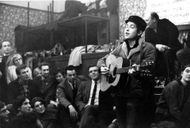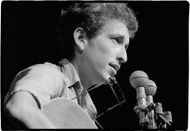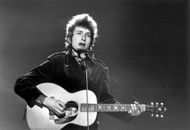Bob Dylan has an immense and one of the most comprehensive collections of songs in modern music. While other artists have achieved a singular substitute for the real thing, Bob Dylan has been influential right from the very start: with his 60s protest songs, his music was on the same wavelength with the turmoil and optimism of that age.
Yet he was not only a master of reflecting reality, but he was able to move beyond it as well. His music, as it developed, became heavier and more enigmatic, most notably during the 90s, when his songwriting started to have a very noir-like intensity.
His knack to blend the past with the reality of today's world is what has turned his records into such products that seem traditional, on the one hand, and conversely, rely on relevance to the present.
Few artists have left such a huge mark on the cultural and musical landscape, and continued to do so, as Bob Dylan. Erupting from the folk revival scene of the early 1960s, Bob Dylan stood out, and not just because of his gravelly voice: his literary songwriting expanded the possibilities of what lyrics in popular music could do and mean.
Unlike many fellow rock stars who came, saw, and disappeared, Bob Dylan proved himself to be the consummate shape-shifter. Every phase in his career has a different feel, whether he's casting politically charged anthems in the '60s, country-influenced turns in the '70s, or spiritual experiments and sonic detours in the '80s.
While some decades have been more contentious than others, Bob Dylan's willingness to engage and evolve, rather than mimic past glories, has kept him relevant. Six decades in, he is both less a ghost of the past than a moving target, an artist whose unpredictability has been as much of a calling card as his harmonica.
Disclaimer: This article contains the writer's opinion. The reader's discretion is advised!
Here are the 10 greatest Bob Dylan songs of all time
Condensing Bob Dylan’s half-century career into ten songs is a virtually impossible challenge. With a six-decade career and a body of work that draws from folk, blues, rock, and gospel, among other elements, Bob Dylan has penned some hundred songs that could each make a reasonable claim for greatness.
His music has been a mirror and a megaphone for the times, threading personal introspection with politics while all the while delivered in his signature lyricism. From epochal anthems to self-healing ballads, Bob Dylan’s songwriting has not only altered the music of the world but also the way we listen, think, feel, and take time to consider.
The following ten tracks represent a cross-section of his genius, songs that have stood the test of time and continue to resonate with fans old and new.
1) Mr. Tambourine Man
Mr. Tambourine Man is a watershed in Bob Dylan’s development as a musician, the dividing line between his old-guard acoustic folk and a lush, word-drunk world where he was free to rhyme anything he wanted with everything. On his 1965 album Bringing It All Back Home, Bob Dylan's is a wide, lyrical trip, acoustic and inward on a record otherwise filled with his first electric explorations.
The Byrds would send the song into mainstream stardom very quickly with the jangly, radio-friendly version of it they'd record in just weeks, but it's Bob Dylan's original that captures every layer of mystery folded into the song. His version is looser than the standard, intertwining surreal images with existential longing in a more free-associative monologue.
When The Byrds made the song a hit in the folk-rock category, they slightly changed its essence, whereas Bob Dylan's version is the heart of the song, an entrancing piece about the magic of creating and human response that has lasted through generations.
Read More: Top 6 J. Cole songs you can't miss
2) The Times They Are a-Changin'
Bob Dylan's world-changing things were getting restless everywhere, and the song ain't just repeating the protests or angry feelings going on then, but instead, it turns all that mess into words that get people to start thinking.
Bob Dylan never puts himself forward as the leader. Bob Dylan never gives a message that kind of floats above everybody, he is telling people to keep changing, whether they want it or not.

The meaning stays strong over time because it can be interpreted broadly for many situations, not just when folks were fighting for civil rights, but also in the case of family fights or contemporary protests for rights and justice. That song is still relevant even today; it not only reminds people of old protests, but it’s the way the song leaves things open that makes it keep ringing out years later.
This tune keeps walking along with history: the words, they rarely stood still, and history never stood still either.
3) Just Like a Woman
Just Like a Woman, which is one of the five singles from Bob Dylan's album Blonde on Blonde. It has been talked about a lot, most of it over how it sounds, and usually it's this arguing that gets remembered most, while the feeling inside the song is sometimes left forgotten.

Framed by fans as a love song, and usually overlooked in the first listen, it has something much deeper in it that makes it seem more real. Dylan writes about intimacy and, subsequently, a lack of it, softly and wistfully.
The song is much more than a reflection of a woman and her relationship with strength. Just Like a Woman is about the love one holds, and slowly over time, how people let go of each other.
4) Desolation Row
Bob Dylan's Desolation Row doesn't start like normal songs at all because it seems to drift on and on with weird stories about all sorts of broken and strange people. And it almost starts in what looks like the pieces of what's left after everything falls apart, and not much hope is left in anyone or protest either.

He just kind of stays still, stands, and tells what he's seen without much feeling, almost like a documentation. Unlike some of his other songs that are kind of confessional, this one doesn't really do that, and instead, we get the sense that he's already kind of given up, like he’s saying the world's been burnt down already, and now it's just the guy that is left.
5) Visions of Johanna
Visions of Johanna doesn't jump right out at you; instead, it quietly drifts in, slow and mysterious, a bit like those dreams you're not sure about. Among all the new tracks on Blonde on Blonde, this track comes off as the most slippery and hard to grasp, while also tugging at emotions the strongest, though it doesn’t try to explain itself with any obvious signs.
There's a quiet, mid-tempo shuffle that you can hear, a kind of pace that doesn't rush the listener, and with that space, the odd, winding verses get to take center stage and just kinda float.
No clear plot, just a rough mosaic made from passing thoughts, strange figures, with a sense of restlessness that runs all through the lyrics. It has been called less of a pop song and more like some unfinished poem, something always changing in your mind when you listen, and this feeling sticks around long after the song ends.
This particular song has become a powerful and moving accomplishment, one that sits there almost unnoticed, until it isn't.
6) Blowin' in the Wind
When Bob Dylan sat down to write Blowin' in the Wind in 1962, he wasn't just writing some normal folk song, but was instead putting into words this feeling many have felt ever since, because real questions were being asked, but no easy answer was given.

Bob Dylan has always been seen as a voice for those who didn't have one. It was released on his second album, The Freewheelin' Bob Dylan (1963), and dropped around the time people were fighting for civil rights, and just about everyone felt worried about what might happen to the world. The lyrics never give solutions, and instead, the feeling of uncertainty resonates in everyone.
After the shocking assassination of President Kennedy, the protest for civil rights, and the Cold War, Blowin' in the Wind was born in urgency. The song was indeed seen as a protest song by many, though people keep listening to it for more than those reasons. It speaks to wanting justice, peace, and just asking to be treated right, something anyone can relate to.
7) Like a Rolling Stone
When Like a Rolling Stone hit the airwaves as the opener for Highway 61 Revisited back in 1965, something new sparked in rock: the big melody, and the sound seemed almost like an explosion, shaking up everything and letting everybody see just how wild rock could get, a change that was felt almost instantly, while listeners were surprised!

Dylan was a master of words, spitting them with a tone of bitterness. The focus of his story is a woman, extremely affected by how quickly things can change.
Instead of opening the album with a gentler or quieter track, Bob Dylan kicked the door open wide, throwing out all the old habits and letting fresh chaos in. Old ways got left behind. The blunt words, the winding verses, and the sharp energy made the song disruptive, the rules were broken.
8) Positively 4th Street
While listeners have been amazed by Bob Dylan changing the shape of music through Bringing It All Back Home, Highway 61 Revisited, and Blonde on Blonde, something completely different happened: Positively 4th Street burst out, sizzling with anger.
This wasn't like the grand, wide poetry swirling through his other records at the time, instead Bob Dylan was zooming right in, he used sharp words to be brought to electric guitar and with a so very smooth and catchy sound, many people couldn't guess right away that the lyrics were actually pretty bitter.
Some folks were surprised, others just tapped their feet along. The arrangement was put together with a light touch. But underneath hid a strong personal feeling, and radios played it lots, but not loudly at all. Bob's audience was divided, and a lot of folks left with music they loved.
9) Tangled Up in Blue
Instead of just being a simple diary that lays out heartbreak plain, Blood on the Tracks spins a puzzle of emotions with stories and personal loss tangled all together like a web that kind of pulls you in and keeps you listening.
Dylan was not simply mourning a broken marriage here because he actually bends the whole thing through weird characters, weird time-jumps, and all kinds of nods to literature that make it kind of tricky to figure out what's real or fiction in these songs. The pain is being rebuilt using the elements that are thrown at anyone, which makes people think more deeply.

Tangled Up in Blue opens the album. It's not just any opener, though.
10) All Along the Watchtower
First showing up on John Wesley Harding in 1967, Bob Dylan's All Along the Watchtower arrived as a fresh inspiration. Even though Dylan employed simple storytelling, fans didn't expect it at the time. The lyrics carry a haunting, almost biblical sense of urgency that pulls listeners in quickly.

Still, late-night radios sometimes are heard playing the original, especially with soaring guitars, as it remains the soundtrack to the kingdom of rock's best, and cannot be ignored. Hendrix’s riffs followed those original words, while something entirely fresh was born to the world.
From Bob Dylan's raw to Hendrix’s roaring version, the track's path has been one of surprises and lasting appeal, and Bob Dylan's setlists have often featured this tune for many years. Now, the track's versatility is shown every time it's played live, cementing its place in music history.
Bob Dylan’s catalog is too large and varied to limit him to just the 10 contributions on this list, but they serve as an engaging picture of his extensive work, spanning several decades of genre-defying material that's helped redefine the sound of contemporary music. From the folk that first brought him groundswell attention, and the poetic protest songs that made him eternal, to a period of electric reinvention and relentlessly restless experimentation, Bob Dylan's discography is a testament to his remarkable powers as both creator and lyricist.
Every album is a different part in the narrative, and it shows no fear from an artist that refuses to attach itself to a particular sound and that explores a range of new territories. In the end, Bob Dylan's music does way more than document one man's decision to turn his back on one's impossible goals; it places him as one of the most important and lasting voices in popular music history.
Keep reading SoapCentral for more informative content!
Also Read: Top 10 Coldplay songs of all time
